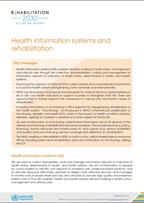
Information
Overview
The WHO 13th General Programme of Work (GPW13) sets in stone measurable goals for the work of WHO, with its 3 targets of 1 billion more people benefitting from universal health coverage, 1 billion more people protected from health emergencies, and 1 billion more people enjoying better health and well-being. To contribute to the achievement of these goals, WHO is supporting the integration of rehabilitation into health systems and strengthening its availability at all levels of health care. Strengthening rehabilitation requires considerable planning and decision-making in countries and this should be underpinned with quality data and information. Therefore, a key action required for successful strengthening is to integrate rehabilitation into health information systems.
Health Information Systems (HIS) serve multiple users and a wide array of purposes that can be summarized as the "generation of information to enable decision-makers at all levels of the health system to identify problems and needs, make evidence-based decisions on health policy and allocate scarce resources optimally".1
The lack of robust and effective HIS often results in a significant gap between what policy-makers, health professionals and researchers know and what they need to know to improve the health of the population. Data from different sources, including from health facilities, population-based surveys, and civil registration and vital statistics systems, can easily be modified or expanded to meet the informational needs of rehabilitation. The WHO Rehabilitation Programme is working toward the integration of rehabilitation into these different data sources and their country implementation.
1 WHO Health Information Systems. Toolkit on monitoring health systems strengthening, 2008.
Resources
1. Health service data
Routine Health Information Systems
Routine Health Information Systems (RHIS) is a subset of Health Information Systems (HIS) that involves the regular collection of data and reporting from health facilities. Routine data from health facilities providing rehabilitation services are essential for decision-making. Standard rehabilitation facility indicators have been developed to guide data collection and to enhance the monitoring and evaluation of the rehabilitation sector capacity and performance.
The Routine Health Information Systems – Rehabilitation toolkit contains the following:
- guidance document for the analysis and use of RHIS for rehabilitation
- digital package that has been developed with District Health Information Software 2 (DHIS2), and
- training resource for data analysis and data entry.
Health Facility Assessments
Data from health facilities are needed for a comprehensive assessment of the functioning of health services and their impact on health. Health facility surveys, which are usually carried out by an external reviewer, provide assurance that health facilities have quality systems in place to provide the required level of services. It is important that these health facility surveys collect information on rehabilitation to determine the level of integration within the health facility.
Rehabilitation has been integrated into the WHO Harmonized Health Facility Assessment to assess service availability and readiness, quality of care and safety, and management and finance practices.
2. Population-based data
Population-based surveys
National population surveys produce nationally representative and internationally comparable estimates of demographic, health, and social indicators. Survey data is usually collected by trained enumerators who conduct interviews with eligible individuals that are selected in a scientifically designed sample, using standardized questionnaires.
A key aim of population-based surveys is to provide measures that consist of point estimates for indicators, which will drive policy development and programme planning, monitoring and evaluation.
The WHO Rehabilitation Programme has developed a global tracer indicator to include in population-based surveys for assessing effective coverage of rehabilitation and population functioning in a given geographic region.
Background paper


